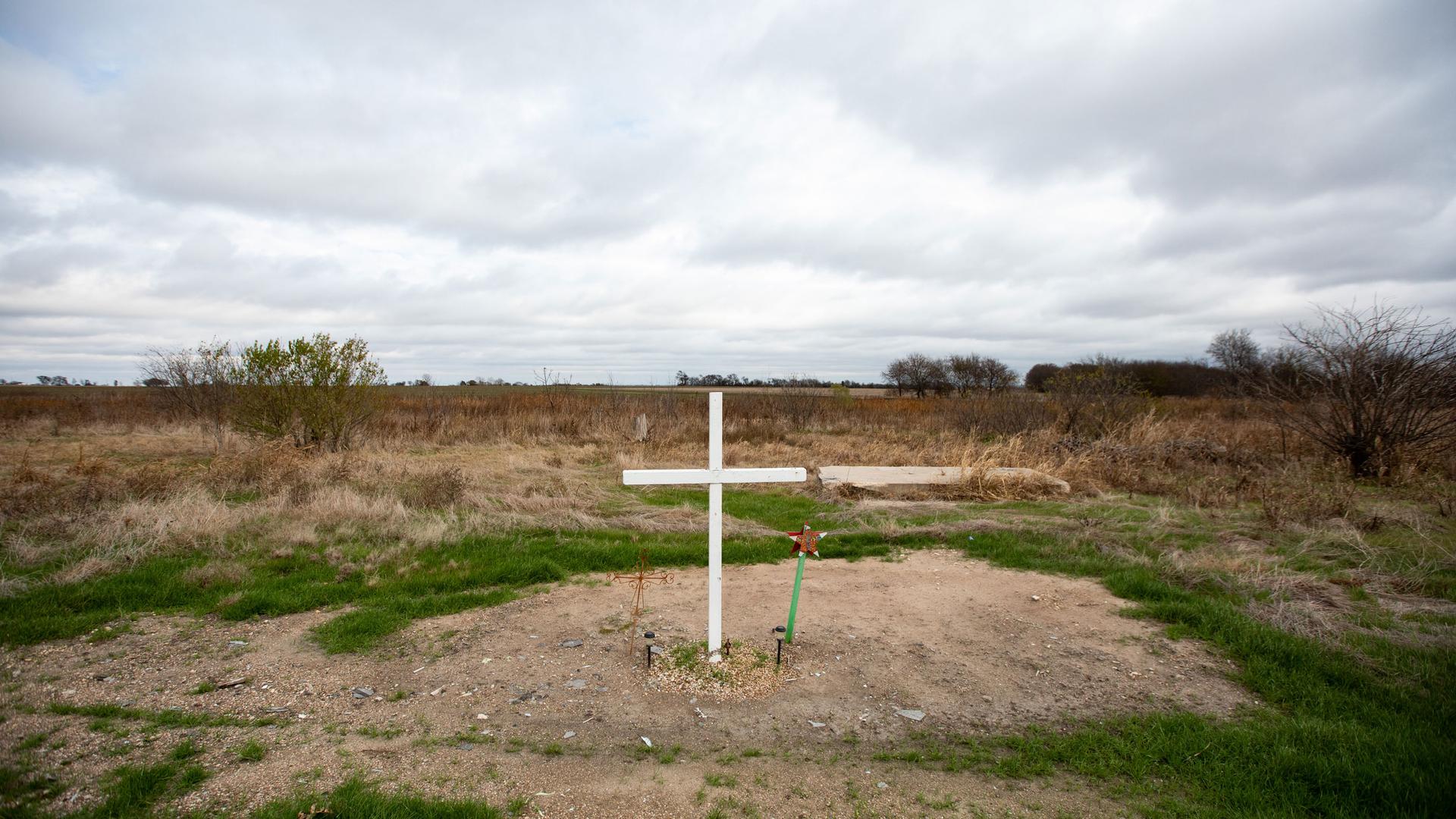A common fertilizer can cause explosions. Uneven regulation puts people at risk.
A cross marks the site of the West Fertilizer explosion in 2013.
This story is part of a series by the Center for Public Integrity, Grist and The World about how our overuse of fertilizer harms the climate and endangers the public.
The blast sent Robby Payne into a plastic tank of liquid cattle feed, knocking him unconscious. Had he not been wearing 25 pounds of firefighting gear, which buffered the impact, he might well have perished. Payne, a college track star-turned-funeral director, remembers none of it. “My memory,” he said, “cuts out sometime before the explosion occurred.”
This he considers a blessing. He came away with a broken ankle, broken ribs, broken cheekbones, broken teeth, a concussion and a slew of gashes. But no recollection of the event itself, which killed 15 people, 12 of them firefighters or other emergency responders. “As far as I was concerned,” said Payne, 58, “I was not there.”
The backstory: At 7:29 p.m. on April 17, 2013, a fire was reported at West Fertilizer, an agricultural-products retailer that had served farmers in Central Texas since 1962. Three plywood bins at the facility were loaded with as much as 60 tons of ammonium nitrate, a granular fertilizer that’s benign under most conditions but can become destructive when stored improperly — as was the case at West Fertilizer — or intentionally detonated.
The Germans used ammonium nitrate in bombs during World War I before it gained popularity as a fertilizer. It obliterated three freighters on Galveston Bay in 1947, killing 581 people and leveling or burning down much of Texas City, Texas, in what remains the nation’s worst industrial accident. Timothy McVeigh used it to blow up the Alfred P. Murrah Federal Building in Oklahoma City and kill 168 people in 1995. Fires at a fertilizer plant in Bryan, Texas, in 2009 and a fertilizer warehouse in Athens, Texas, in 2014 had calamitous potential but wound up hurting no one.
Despite the threat it poses, fertilizer-grade ammonium nitrate is not as closely regulated as it could be. It was left off a list of hazardous substances marked for special attention by the US Environmental Protection Agency. Its purveyors escaped, through a judge’s decision, tougher scrutiny by the federal Occupational Safety and Health Administration. Location-specific information about it is hard to come by, ostensibly for security reasons. In most states, there’s no easy way for the public to know where ammonium nitrate is kept in amounts big enough to do harm.
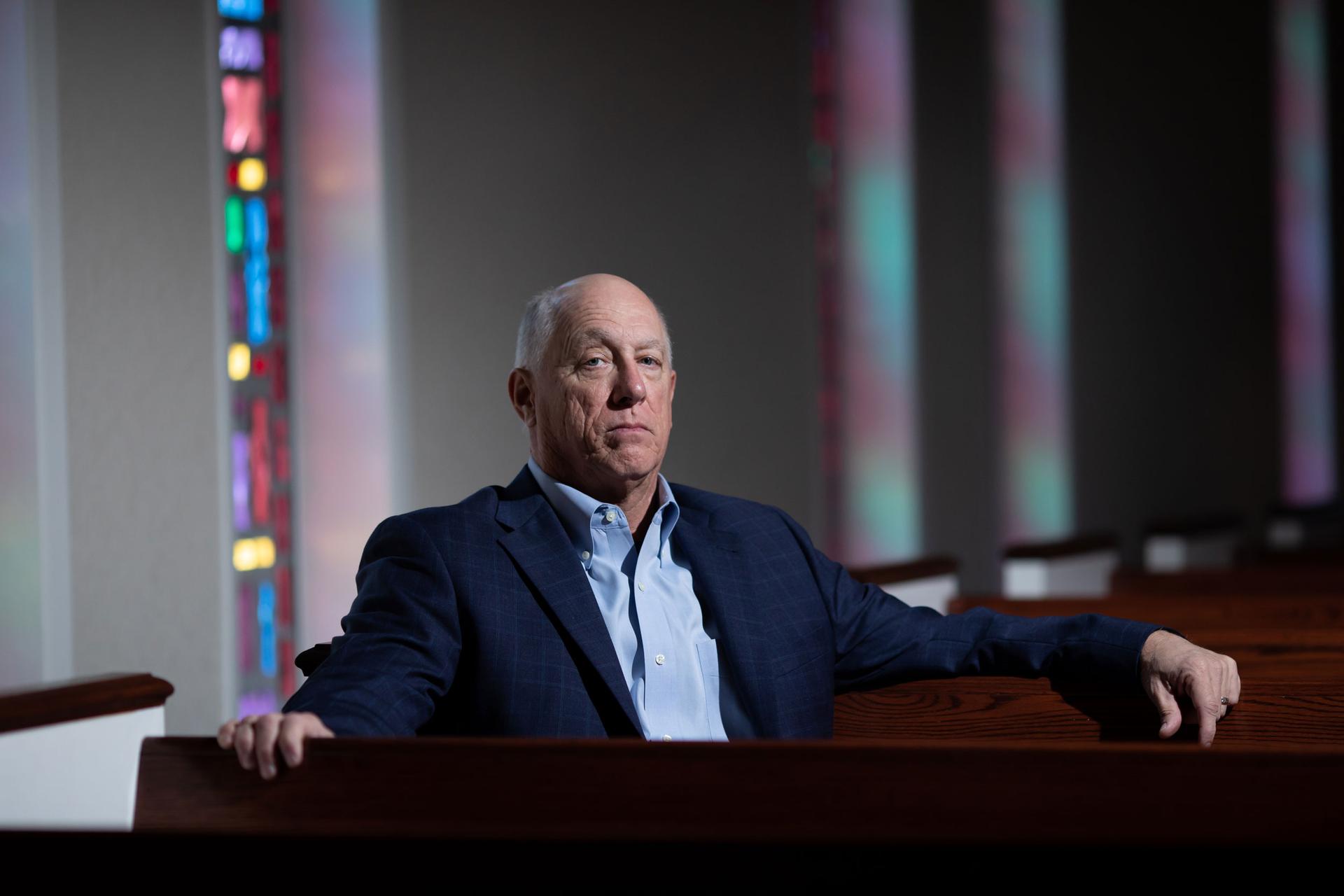
Under President Barack Obama, the EPA issued a rule aimed at preventing explosions, fires and toxic releases from chemical plants, oil refineries and smaller facilities such as West Fertilizer. Under Obama’s successor, Donald Trump, the agency excised or weakened key provisions of the rule, which it described as “burdensome.” Some of these provisions were designed to protect first responders like Robby Payne.
‘There was this wall of explosion’
Minutes after the fire at West Fertilizer was called in, Payne and about two dozen other members of the town’s volunteer fire department were on the scene, oblivious to the existential risk presented by the melting piles of ammonium nitrate. They were wary only of two 12,000-gallon tanks of anhydrous ammonia, a liquid fertilizer that can be deadly when released as a vapor and inhaled in high concentrations.
Tommy Muska, an insurance agent and West’s mayor, was part of the firefighting crew. At 7:51 p.m., Muska was walking toward the burning building when, he said, “there was this wall of explosion, a very, very bad, loud explosion. There was just a wall, and then it hit me and knocked me back four or five feet. And then I got up and there was nothing there.”
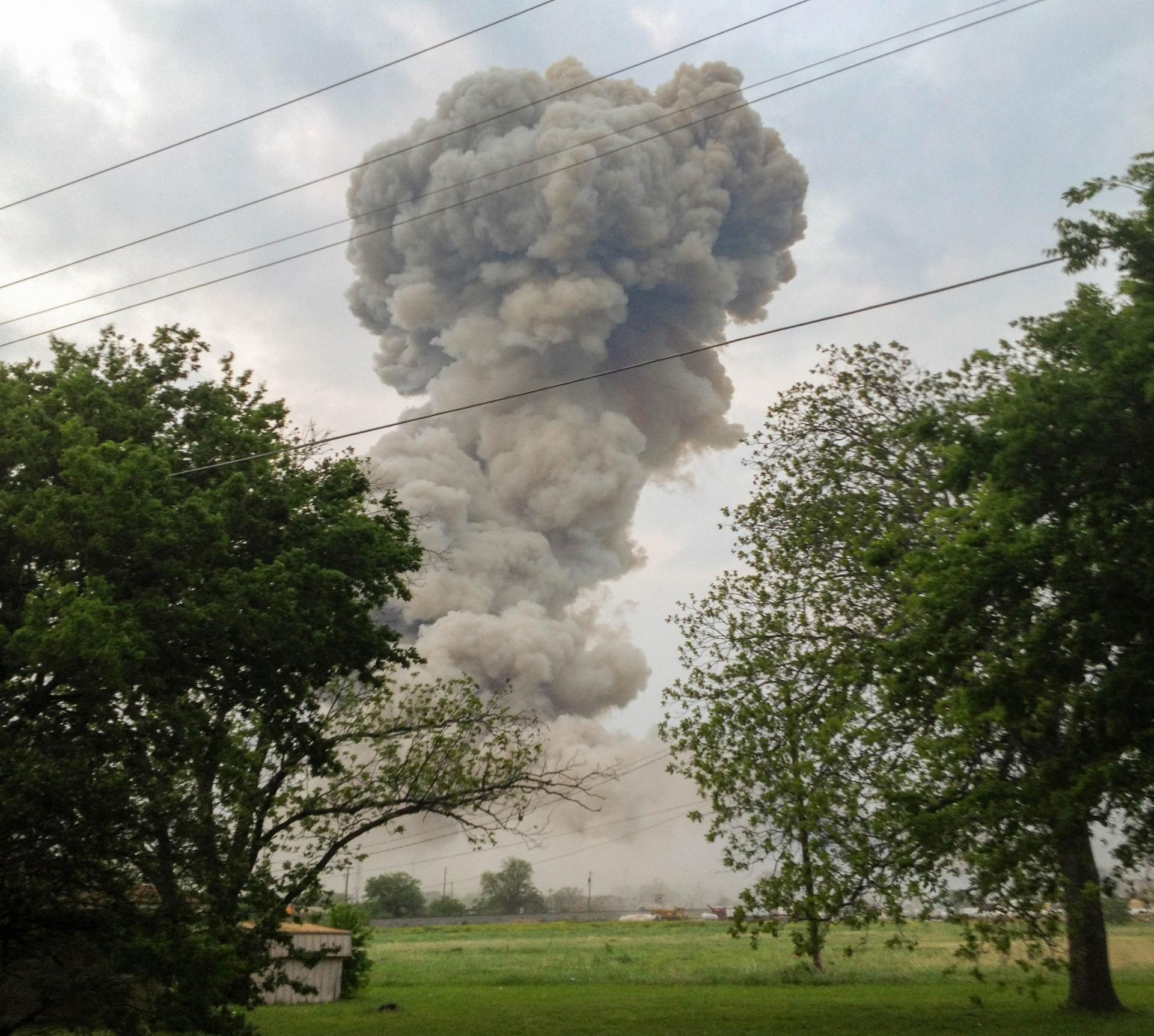
More than 260 people were injured in the blast, which registered 2.1 on the Richter scale, typically used to measure the strength of earthquakes. One hundred forty-two houses, a nursing home, an apartment complex and two schools — West Intermediate and West High — were damaged beyond repair. Had the explosion occurred earlier in the day, while classes were in session, 665 students and 86 staff members would have been at risk of injury or death, according to a 2016 report by the US Chemical Safety Board.
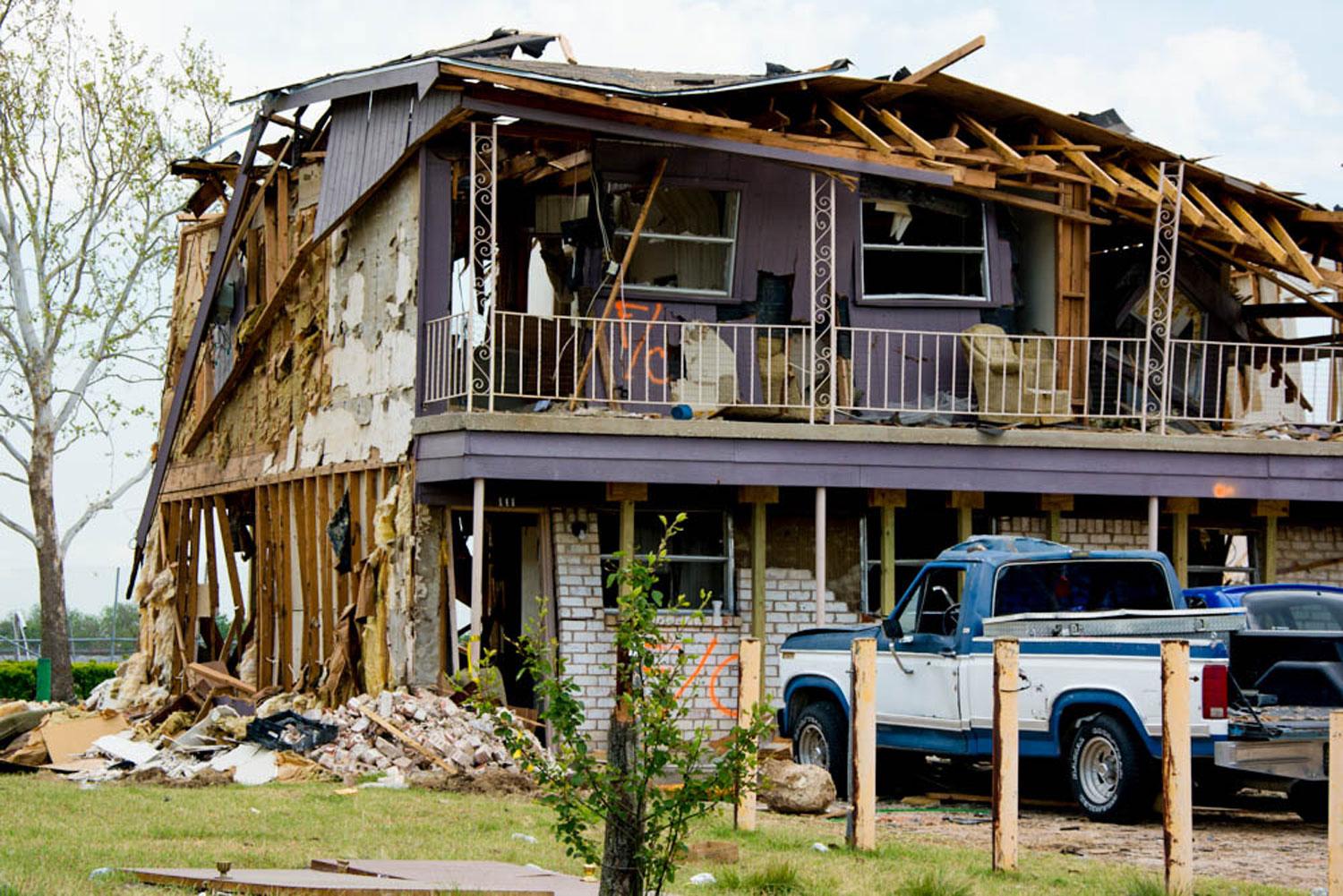
The catastrophe touched off a 4 ½-year legal battle between the city of West, two ammonium nitrate manufacturers whose products had been stored at West Fertilizer, and a fertilizer broker. The city’s lawsuit, settled out of court for nearly $10.5 million in January 2018, alleged that the manufacturers and the broker failed to warn operators of West Fertilizer about the destructive properties of ammonium nitrate. Hundreds of other cases — for deaths, injuries or property damage related to the accident — were filed; most have been settled.
According to The Fertilizer Institute, a trade group, an estimated 601,000 tons of ammonium nitrate were applied to crops in the United States from July 2016 through June 2017, the most recent period for which data are available. That made it the eighth most-used fertilizer in the country and accounted for about 3 percent of global consumption of the product.
In an email, a spokeswoman for the institute wrote that “there has been a significant reduction in the consumption of ammonium nitrate. Therefore, there are many fewer facilities who handle the product, reducing any potential risks associated with this material as a consequence.” At 585 sites nationwide, however, it’s still stored in quantities large enough to require oversight by the Department of Homeland Security.
Ammonium nitrate can be destabilized by an exceptionally hot fire, causing the pellets to melt. A powerful oxidizer, it can add fuel to such a fire, making it burn even hotter. Confinement elevates the risk of detonation, as does contamination by organic material such as dirt, grain or oil. Both conditions existed at West Fertilizer at the time of the accident, according to the Chemical Safety Board.
The blast forced a re-examination of federal rules meant to prevent such tragedies. Obama, who spoke at a memorial service for the West victims on April 25, 2013, issued an executive order that August pressing authorities to find ways to reduce risks posed by hazardous chemicals. Public-safety advocates and environmentalists felt they’d finally been heard. The EPA had documented 2,291 fires, explosions and chemical releases at high-hazard sites from 2004 to 2013, but what happened in West — a town of 2,800 people, many of Czech descent, 15 miles north of Waco — was a tipping point.
Over the next 3 ½ years, industry groups argued against broad amendments to the EPA’s Risk Management Program. “These requirements will simply increase operating costs, paperwork burdens, and compliance costs rather than making it more likely to prevent an accidental release,” the Agricultural Retailers Association said in written comments to the EPA.
It and The Fertilizer Institute launched a voluntary safety initiative called ResponsibleAg, which, the groups insisted, was superior to any sweeping new mandates. (To date, 94 facilities that handle ammonium nitrate have registered with the program, the institute’s spokeswoman said. Of these, 34 have been certified as meeting all federal safety standards, though this “does not guarantee safety. Safety is an ongoing process.”)
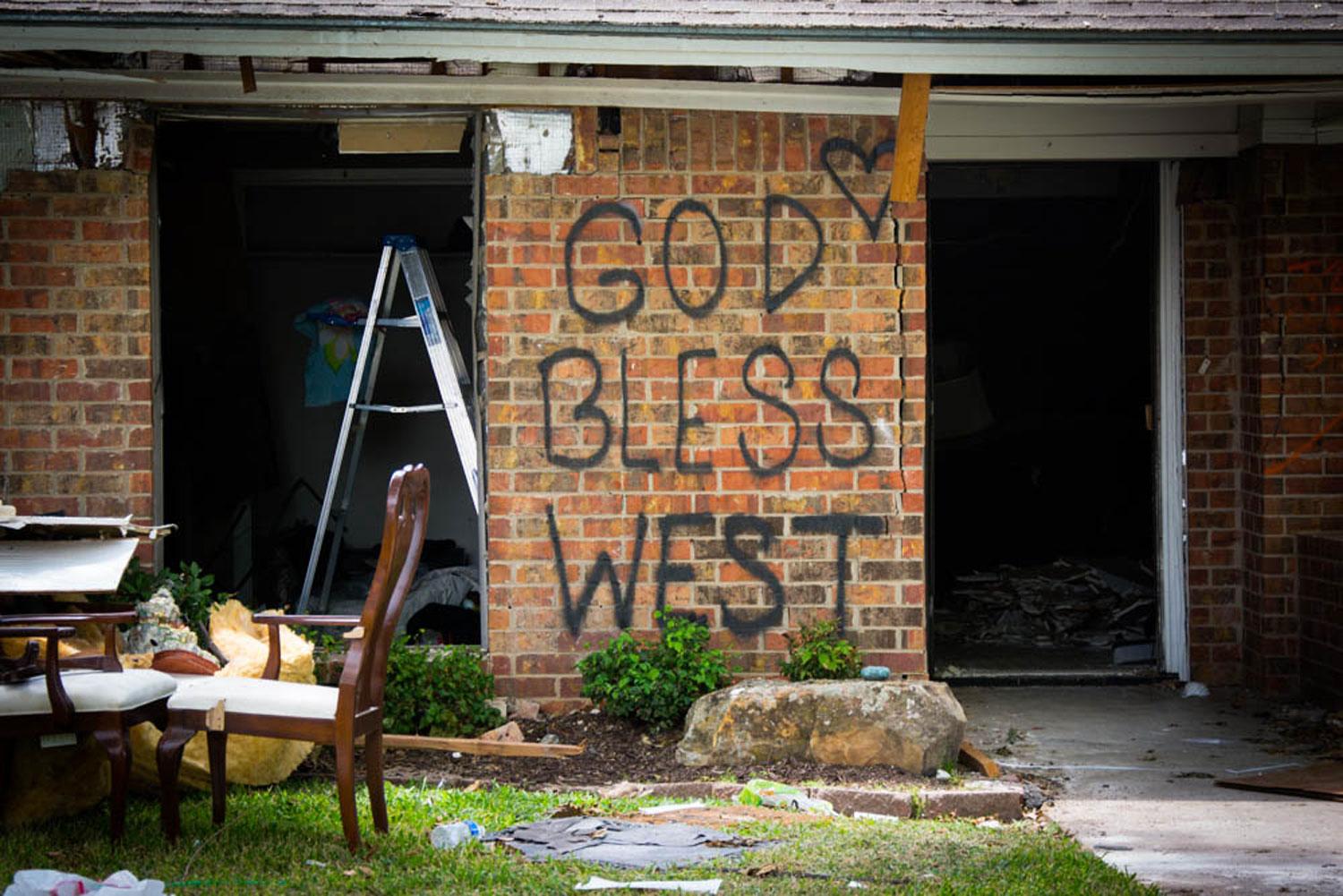
In its comments to the EPA, the Coalition to Prevent Chemical Disasters — composed of more than 100 organizations, including Greenpeace and the Union of Concerned Scientists — cited congressional testimony in June 2013 from the Chemical Safety Board’s then-chairman, Rafael Moure-Eraso, who warned that “ammonium nitrate fertilizer storage falls under a patchwork of US safety standards and guidance — a patchwork that has many large holes.” Among them: the use in some places of combustible, wooden buildings and storage bins — like those at West Fertilizer — and no legal restrictions on the storage of large quantities of ammonium nitrate near homes, schools and hospitals.
When the EPA put out what became known as the Chemical Disaster Rule in the waning days of the Obama administration in January 2017, it met with disappointment from some who felt it went too easy on chemical manufacturers and users. The agency, for example, didn’t add ammonium nitrate to its list of “highly hazardous” chemicals regulated under the Risk Management Program, saying the fertilizer’s storage and handling already were addressed by OSHA and DHS rules.
Even critics conceded, however, that the EPA rule was an improvement over what had been on the books. Among other things, it required companies to consider “inherently safer technologies” and commission safety reviews by outside auditors after significant accidents. The companies would have to share chemical hazard data and conduct training exercises with emergency responders.
Enter Trump. First his administration tried to postpone the effective date of the rule. Thwarted by a panel of judges, it set about extracting elements, such as third-party audits and safer-technologies assessments, and modifying others. This time it succeeded: In November, the EPA issued a “reconsideration rule” it said would save $88 million a year in regulatory costs without compromising safety. A spokeswoman declined to answer questions about the rule from the Center for Public Integrity, Grist and The World, referring a reporter to this fact sheet.
The rollback prompted lawsuits from the public-interest law firm Earthjustice and the United Steelworkers. “At the end of the day, these changes will make the public and fire fighters less safe,” the International Association of Fire Fighters said in a statement.
West’s mayor agrees.
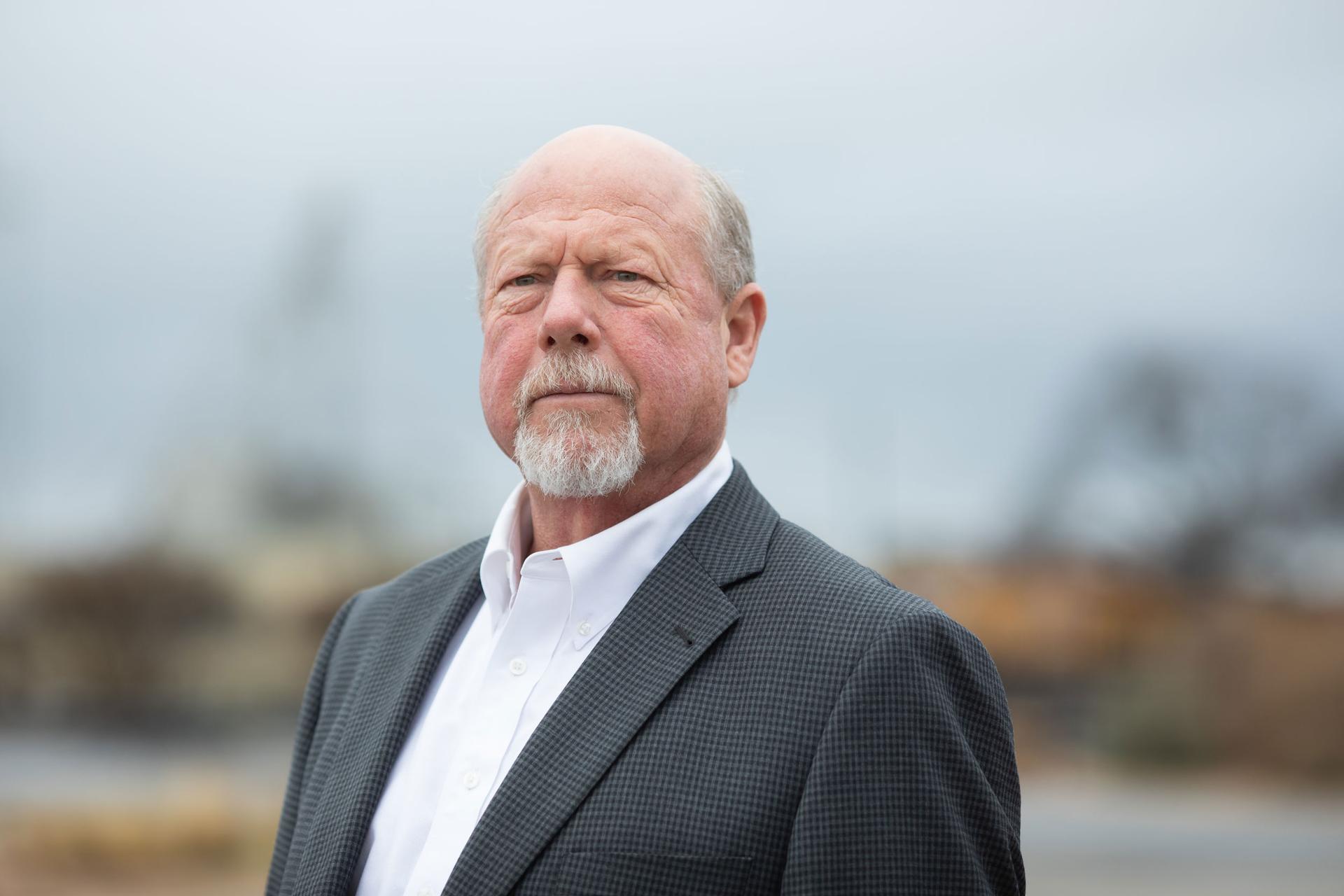
“Unfortunately, Washington has a short memory,” Muska said by phone in January. “[The 2013 accident is] still fresh in our minds here in West, but we’re yesterday’s news. It’s going to happen again — it’s just a matter of time.”
Texas shuts down public information
Less than a year after the explosion in West, the Texas State Fire Marshal’s Office inspected an industrial site in Hopkins County, a major farming region about an hour northeast of Dallas.
The building was collapsing and decaying, according to an inspection report obtained by Public Integrity and its partners. Outside, the inspector found that uncut grass, weeds and other vegetation had grown up against the building’s combustible siding.
Graver dangers lurked inside the building, records show.
The inspector spotted a gasoline container at the front door. Corroded extension cords laced through the walls, serving as permanent electrical wiring for dim rooms and corridors without emergency lighting.
The building lacked a fire alarm and sprinkler system. It had no working fire extinguishers and not a single “exit” or “no smoking” sign. The inspector found an unmarked wooden bin containing 45 tons of ammonium nitrate stored next to a room where workers used welding tools to repair mechanical equipment.
The building was located within two miles of residential neighborhoods and next door to a site where two fires had broken out that year, records show. The inspector noted that the unkempt vegetation between the two facilities “could sustain a fire” that risked engulfing the fertilizer building, possibly triggering “substantial property damage and evacuations.”
Despite laws designed to warn the public about the health and safety threats posed by chemicals, the state of Texas won’t release the name of the building, identify its owners or reveal any details about its location beyond the 767-square-mile county in which it resides.
Federal disclosure rules for hazardous chemicals were born after a horrendous industrial accident on the other side of the world. In December 1984, about 45 tons of methyl isocyanate gas escaped an insecticide plant owned by a subsidiary of US-based Union Carbide and wafted over a densely populated region in Bhopal, India, killing an estimated 15,000 to 20,000 people. Investigators blamed the accident on understaffing and poor operational and safety procedures at the plant.
Stateside, public concern pushed Congress to act. In 1986, legislators overwhelmingly approved the Emergency Planning and Community Right-to-Know Act, which then-President Ronald Reagan signed later that year. The law, which the EPA called the first of its kind in the world, was written to reduce the likelihood of an industrial disaster and ensure the public and first responders know about hazardous chemicals in their communities — how they’re being handled, used and released into the environment.
Under the law, known as EPCRA, operators of businesses where certain dangerous chemicals are stored beyond specific threshold amounts are required to report that information to local and state agencies, which enforce the federal law.
These inventory reports are supposed to detail the types and amounts of chemicals stored and the facility’s location. This information should then be accessible to emergency authorities — and the public — but an investigation by Public Integrity and its partners shows states have vastly different interpretations of the law.
Public Integrity and its partners sought lists of facilities where ammonium nitrate is handled, sold or stored from more than a dozen states. Among them are the nation’s top agricultural producers and ones identified by the US Government Accountability Office as having the largest number of ammonium nitrate facilities.
Texas is one of the most secretive.
Some states, including Illinois, Iowa and Nebraska, provide chemical information to the public on a state government website — either as a downloadable spreadsheet or a searchable web application.
Others, including Georgia, Minnesota, Missouri and Wisconsin, provided lists when asked.
But Texas, where a lack of public information proved deadly in West, said no. The state’s Department of Insurance, parent agency of the fire marshal’s office, cited an attorney general’s determination under a state law that prevents public release of information “more than likely to assist in the construction or assembly of an explosive weapon or a chemical, biological, radiological, or nuclear weapon of mass destruction.”
Emergency officials in Kentucky and Tennessee also declined to provide a list of ammonium nitrate facilities. Their counterparts in Alabama and North Carolina said they would provide information only if it was requested for specific facilities. California and Indiana had not finished processing the requests before the publication of this article.
Fears that releasing information — even details easily found through other means, including phone books and internet search engines — could lead to terrorism are largely tied to the 1995 bombing of the Murrah building in Oklahoma City. The bomb used in that attack was built with ammonium nitrate and diesel fuel.
But Timothy McVeigh and Terry Nichols used an alias to buy the 4,000 pounds of fertilizer for the bomb, according to federal prosecutors. They didn’t steal it. Kansas, where the fertilizer was purchased, released a list of ammonium nitrate facilities to Public Integrity and its partners because officials considered it to be in the public interest. So did Oklahoma, where the weapon was detonated.
Erin Hatfield, a spokeswoman for the Oklahoma Department of Environmental Quality, said the agency “values transparency and the public’s right to know.”
Even as one Texas agency is working to keep the information secret, another publishes details about fertilizer facilities on its website. The Texas State Chemist, charged with overseeing feed and fertilizer companies, regularly updates a list of businesses permitted to sell fertilizer — including their full addresses.
“We can’t speak for other agencies’ practices,” Texas Department of Insurance spokesman Jerry Hagins said.
The disaster in West scared Texans into pressuring state legislators for action. Lawmakers told the state fire marshal’s office to inspect ammonium nitrate facilities and prepare a report. The office has since conducted 376 inspections, Hagins said.
During hearings on the accident, the then-chairman of the House Homeland Security and Public Safety Committee asked officials if they could identify all ammonium nitrate facilities in the state.
“If we can do it with sex offenders, why can’t we do it with ammonium nitrate?” asked Rep. Joe Pickett, a Democrat from El Paso, according to the Dallas Morning News.
Seven months after the accident, the fire marshal’s office debuted a web application that allowed the public to enter a ZIP code and generate a map of facilities where more than 10,000 pounds of ammonium nitrate were stored. (A 2018 presentation by the fire marshal said 104 such sites had been identified). The application provided some location information but didn’t give users the specific address of facilities — just their general locations.
In April 2014, the agency changed the application so only the facilities in the ZIP code entered by the user were displayed, emails obtained by Public Integrity show.
By the fall of 2016, a string of rulings under Attorneys General Greg Abbott and Ken Paxton ordered that all location information about ammonium nitrate facilities in Texas be kept secret.
The application was scrubbed from the agency’s website after — according to the fire marshal — it got 22,941 hits. No trace of it remains.
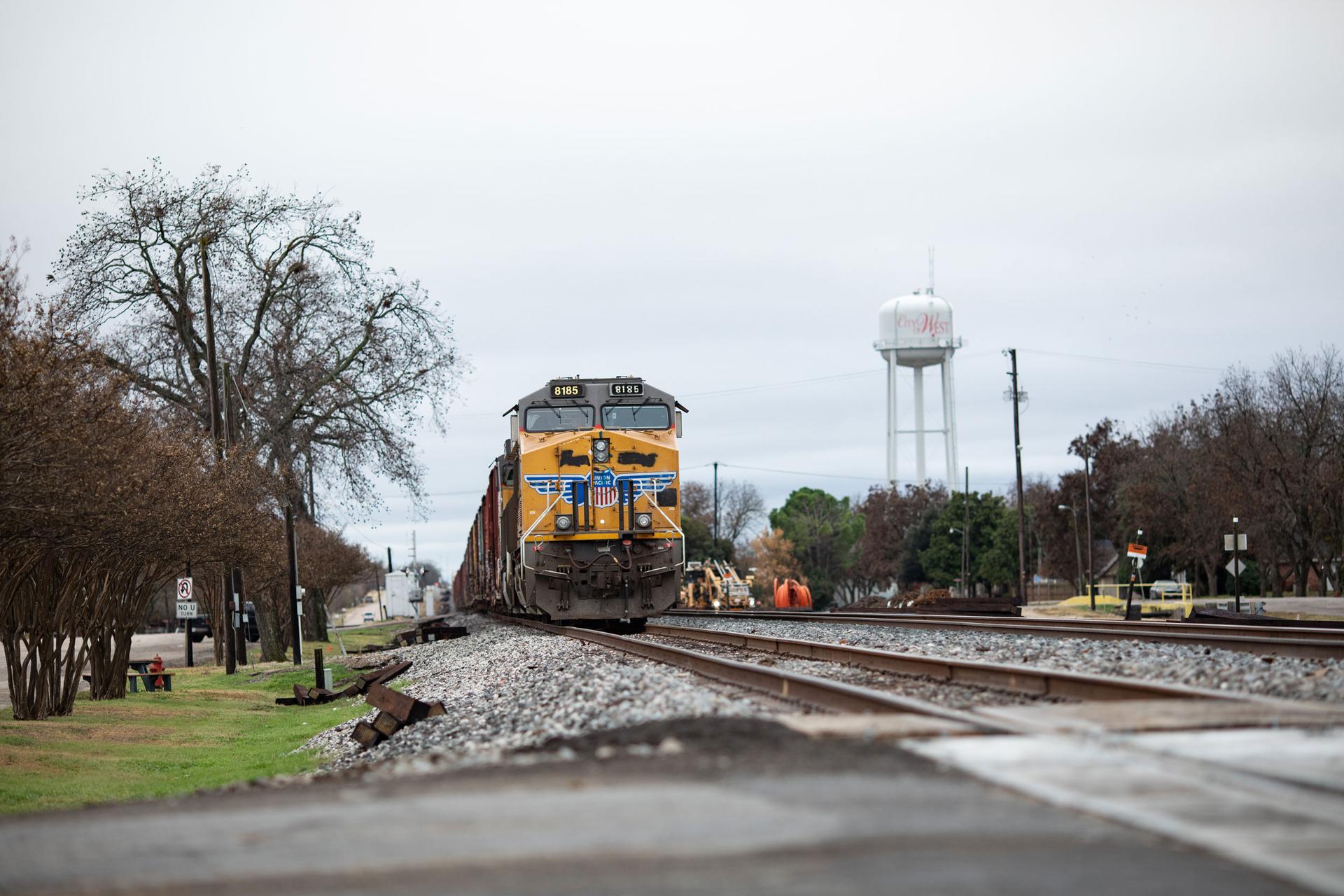
Arson or accident?
The day after West Fertilizer blew up, the Chemical Safety Board — an investigative body with no regulatory powers, modeled after the National Transportation Safety Board — deployed a team of investigators to the Central Texas prairie. Among them were Don Holmstrom, who directed the board’s Western Regional Office in Denver at the time, and Johnnie Banks, a supervisor based at the board’s Washington headquarters. Both have since retired.
Holmstrom, who was with the board from 1999 to 2016, had been summoned to cataclysmic scenes before. Among those were the aftermaths of blasts at the BP refinery in Texas City in 2005, which killed 15 workers, and the Tesoro refinery in Anacortes, Washington, in 2010, which killed seven. But he was unprepared for what he saw in West, parts of which looked as if they had been bombed from the air.
“The offsite consequences were enormous,” Holmstrom said. He found it remarkable that “a modest agribusiness with a relatively small footprint could create such a catastrophe.”
He and Banks, who left the board in 2017 after 16 years, said their team was impeded by agents with the Justice Department’s Bureau of Alcohol, Tobacco, Firearms and Explosives who had been brought in to conduct a criminal investigation. At one point, Holmstrom said, board investigators were banished from the cordoned-off blast site.
“We didn’t want to create any immediate friction, so we left,” Holmstrom said.
“From the outset, there was resistance to allowing us to have full access to the site because a criminal act had not been ruled out,” Banks said. Although there was no evidence of a crime, he said, the ATF kept board investigators at arm’s length, limiting their ability to gather forensic evidence and interview eyewitnesses. “We proceeded with our investigation as best we could,” Banks said. He and Holmstrom determined the fire to be accidental and believed faulty wiring may have been the source of ignition. The wooden building was combustible and had no automatic sprinkler system to suppress the flames; it wasn’t required under the law.
More important than the source of the fire, Banks said, were the conditions that allowed West Fertilizer to wreck 37 blocks of a small town. “Our main focus was to ask why 15 people died,” he said. “There was a profound lack of awareness of fighting an ammonium nitrate fire — that’s why [firefighters] were in harm’s way. There was the lack of a rigorous storage process, the lack of robust land-use planning, where houses and schools were a stone’s throw from this facility.”
In a 2014 report, the Government Accountability Office called attention to lapses by the EPA and OSHA. The EPA explained that ammonium nitrate was not covered by its Risk Management Program “because it was not considered a toxic or flammable chemical,” the GAO said. Nor was West Fertilizer covered by OSHA’s Process Safety Management standard, intended to prevent the sort of incident that ruined a sizable section of West. An exemption in the standard for retail facilities absolved their owners of responsibilities such as hazard evaluation, employee training and compliance audits, the GAO found.
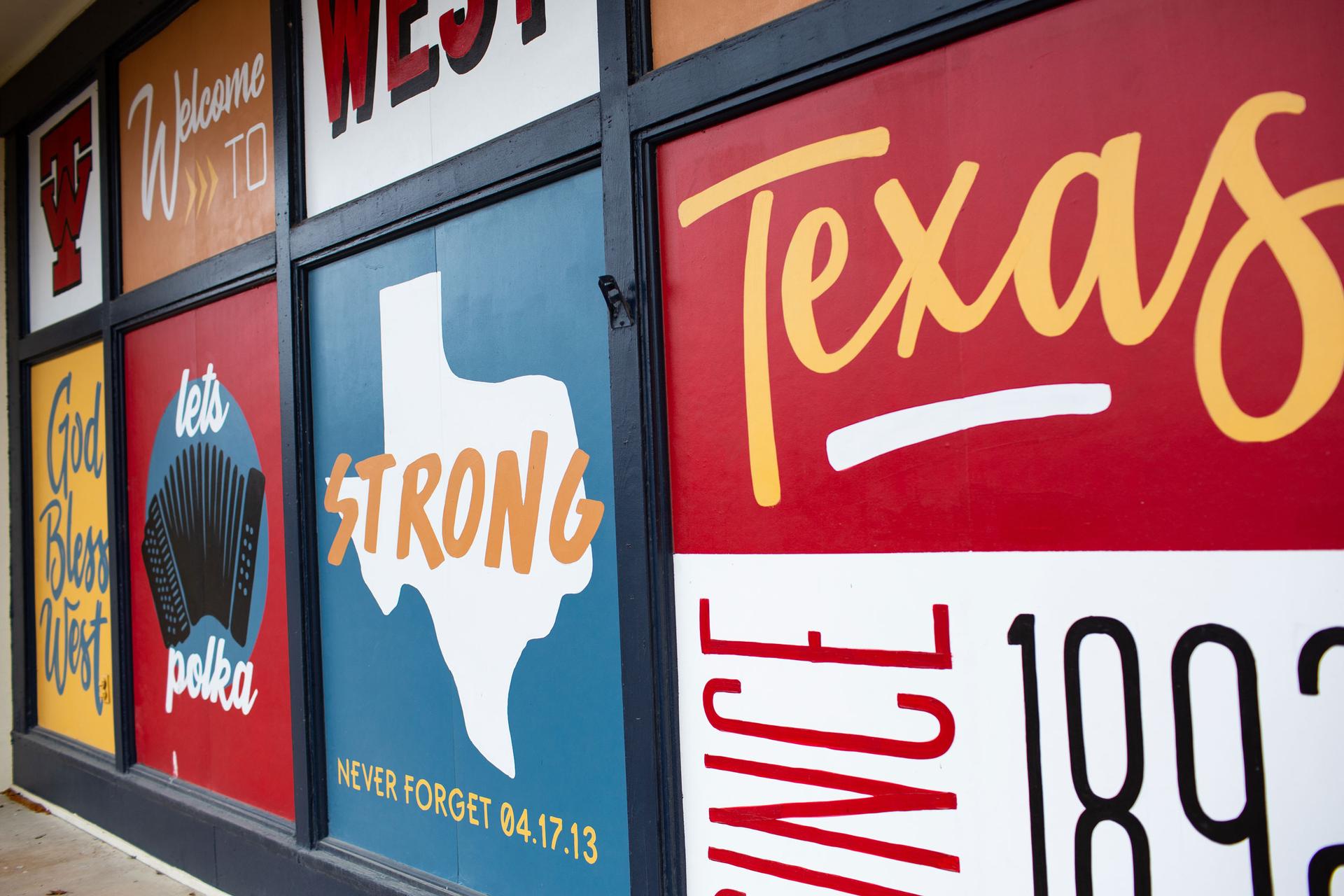
OSHA sought to close this loophole in 2015 with a directive changing its interpretation of the retail exemption. The exemption was carved out for businesses, such as gas stations, that sell hazardous chemicals in “small packages, containers, and allotments,” the memo said. It “should never have been interpreted to cover facilities engaged in distinctly wholesale activities” — such as West Fertilizer — which “handle large, bulk quantities of materials.”
The Fertilizer Institute and the Agricultural Retailers Association challenged the new interpretation in court, saying OSHA should have gone through a formal rulemaking process. The trade groups won, and OSHA retreated. “We were disappointed,” said David Michaels, who led the agency at the time. “A rulemaking would have required many years. Given the experience at West, we thought it was imperative to move quickly.”
In its final report on the accident in January 2016, the Chemical Safety Board chronicled a list of errors and missed opportunities. It noted, for example, that West Fertilizer had failed to report its 120,000-pound ammonium nitrate stockpile to DHS under the department’s Chemical Facility Anti-Terrorism Standards program. As a result, the board said, there was no DHS inspection that “might have noted the storage conditions at the … facility and prompted change.”
The EPA erred in not listing ammonium nitrate under its Risk Management Program and thereby adding another layer of protection to places like West Fertilizer, the board said. This was crucial given the “alarming number of [ammonium nitrate] facilities located in communities — next to schools, hospitals, residences, and businesses.”
Four months after the board’s report came out, ATF officials held a press conference at the West Knights of Columbus Club, about a mile north of the blast site. Saying “all viable accidental and natural fire scenarios were hypothesized, tested and eliminated,” the bureau announced it had settled on arson as the cause of the fire. It offered a $50,000 reward for information leading to the perpetrator or perpetrators. No arrests have been made, and the investigation remains open.
Tommy Muska and many others in town were flabbergasted by the announcement. Muska called the finding “bullshit” and the reward “a complete joke” considering the number of lives lost and the $200 million in damage inflicted. “It’s covering the ATF’s ass is what it’s doing.”
In any event, the mayor said, “It doesn’t matter how it started. You could have had a cow in there kick a bucket over and start a fire — it still blew up.”
In a 2017 article in the Journal of Fire Sciences, fire-safety consultant Vytenis Babrauskas was unsparing in his critique of the ATF, calling it “highly troubling when a governmental agency makes an accusation of arson, yet offers no motive (or an insubstantial potential motive).” Babrauskas cited an editorial in Industrial Fire World that was similarly critical: “Even more worrying is the ATF’s assumption that if it cannot figure out what caused the fire and explosion then it must be skullduggery, not a flawed investigation.”
(In an email to Public Integrity and its partners, an ATF spokeswoman wrote, “In strict accordance with the Scientific Method, Investigators developed, evaluated, tested and subsequently eliminated all reasonable hypothesis as to origin and cause of the fire, except for one hypothesis. The only hypothesis that could not be eliminated and was validated by extensive testing at [ATF’s Fire Research Laboratory], was that the cause of the Fire was incendiary.”)
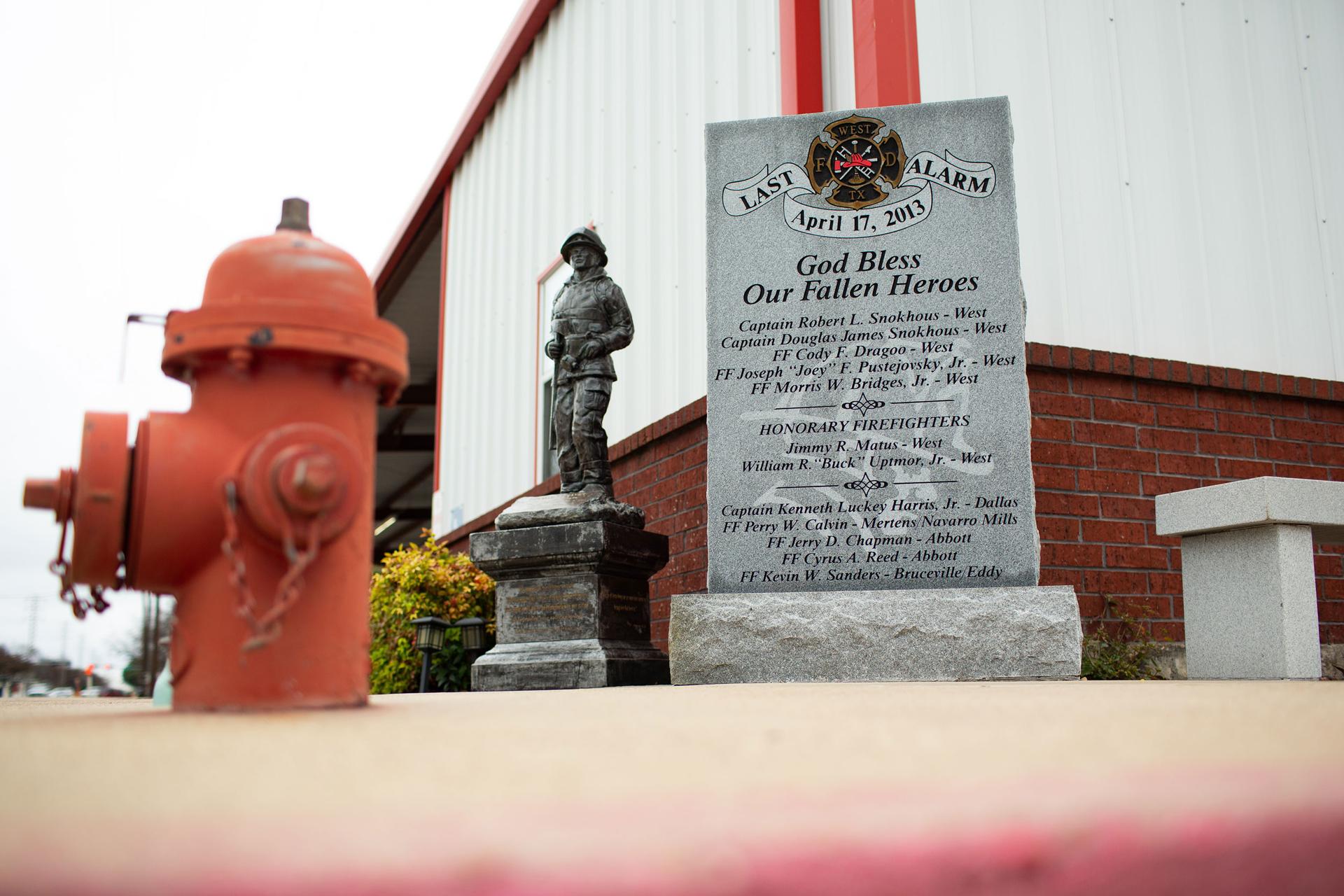
Babrauskas also reproached the EPA, OSHA and DHS for allowing perilous conditions to exist for decades at West Fertilizer.
“There’s one — and only one — cause of an [ammonium nitrate] explosion, and that is an uncontrolled fire,” he said in an interview. “As soon as you realize that, the solution should be obvious to a third-grade student. You simply make uncontrolled fires impossible” by requiring that the fertilizer be stored only in non-combustible buildings and not wooden structures. He characterized the government’s performance in this regard as “grotesquely incompetent.”
Industry groups nonetheless seized upon the ATF’s arson finding in arguing against stricter regulations. At an EPA public hearing in April 2017, Richard Gupton of the Agricultural Retailers Association questioned the logic of basing new requirements for an industry “struggling with low commodity prices” on damage caused by an “intentionally set fire.” (The association did not respond to requests for comment from Public Integrity).
While ammonium nitrate is not listed under the EPA’s Risk Management Program, anhydrous ammonia is. Both products were sold by West Fertilizer; therefore, it fell within the program’s reach. Key provisions of the recently scaled-back Chemical Disaster Rule would have applied to facilities like it.
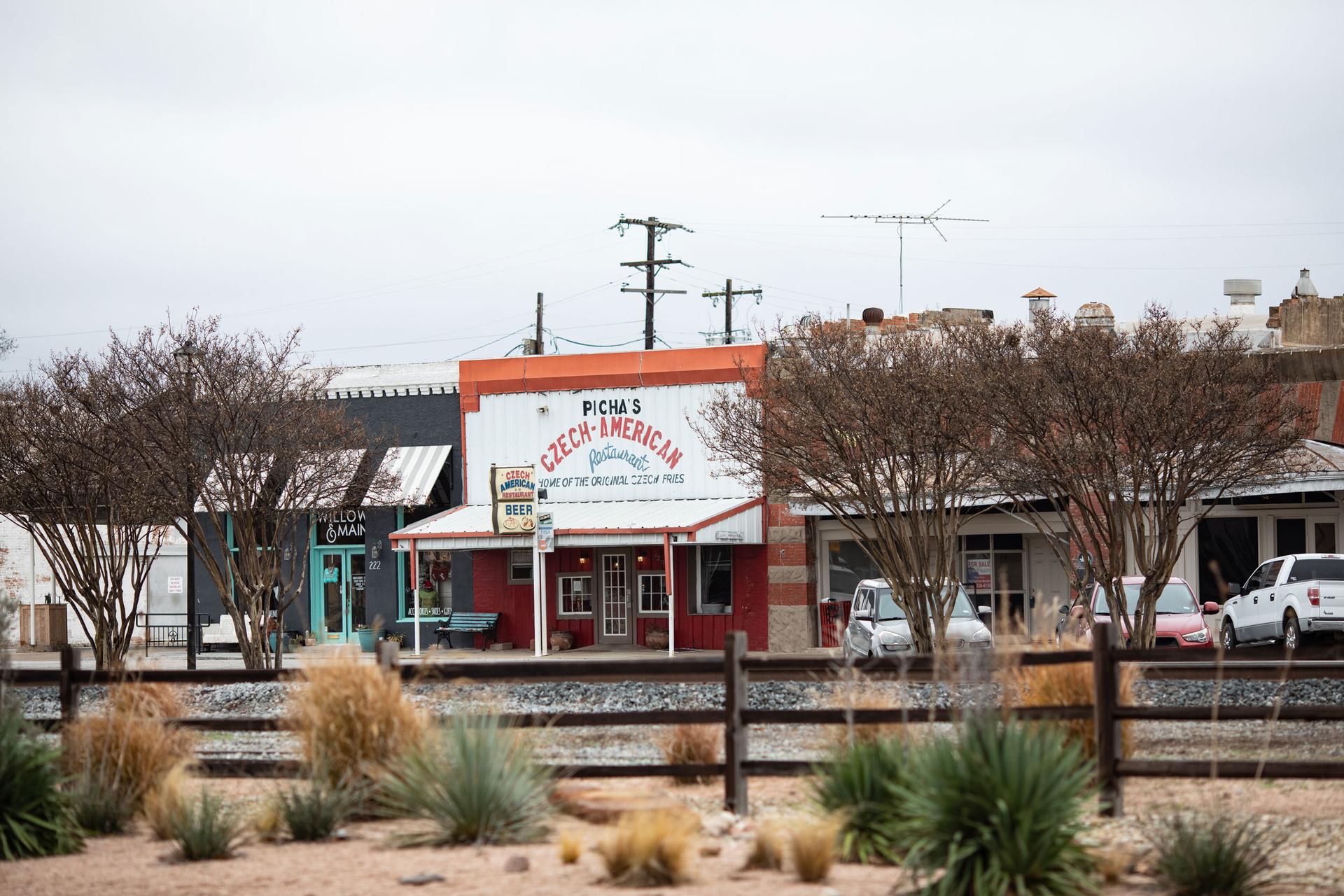
Even if the West Fertilizer fire were arson, that doesn’t diminish the threat posed by hazardous chemicals at thousands of locations around the country, said Gina McCarthy, who led the EPA during the Obama administration. “Nor does it negate the fact that if these facilities don’t take a look at root causes [of accidents] – which they don’t unless they’re told to – these risks can persist and lead to deaths,” said McCarthy, now president and CEO of the Natural Resources Defense Council. “That’s why we regulate them.” (Just last week, a massive explosion at an industrial warehouse in Houston killed two people, injured 20 and damaged about 200 homes.)
In its fact sheet, the EPA says the reconfigured Chemical Disaster Rule “retains all of the prevention provisions that have resulted in the long-term trend of fewer significant chemical accidents.”
In an email to Public Integrity and its partners, OSHA said it launched a special inspection program in nine southern and Midwestern states a year ago targeting facilities likely to handle or store ammonium nitrate. The agency has cited 10 employers in Texas, Nebraska, Kansas and Missouri for alleged safety violations under the program.
DHS said it considers 88 of the 585 ammonium nitrate operations that fall under its Chemical Facility Anti-Terrorism Standards program to be “high risk.” Of these, the agency said, 77 have approved security plans that include perimeter security and background checks for people with access to chemicals.
The city of West’s lawsuit maintained that the ammonium nitrate manufacturers — CF Industries and El Dorado Chemical — shared blame for the explosion. The companies “acted negligently by refusing to satisfy the principles of product stewardship and, in particular, by failing to visit the facility before a sale and ensure proper management of the product,” said a response to the defendants’ motion for summary judgment in 2015.
The general manager of West Fertilizer, Ted Uptmore, testified in a deposition that neither the manufacturers nor a fertilizer broker, Inter-Chem, told him the ammonium nitrate was being stored in an unsafe manner or that it could cause an explosion, the pleading states. Had he known, Uptmore testified, he would have made changes in the operation.
El Dorado declined to comment, and CF Industries and Inter-Chem did not respond to messages from Public Integrity and its partners. The defendants’ motion said they “owed no duty to warn a professional, regulated and highly experienced fertilizer distribution and blending company, like West Fertilizer.” The explosive capabilities of ammonium nitrate, the motion said, were “well understood.”
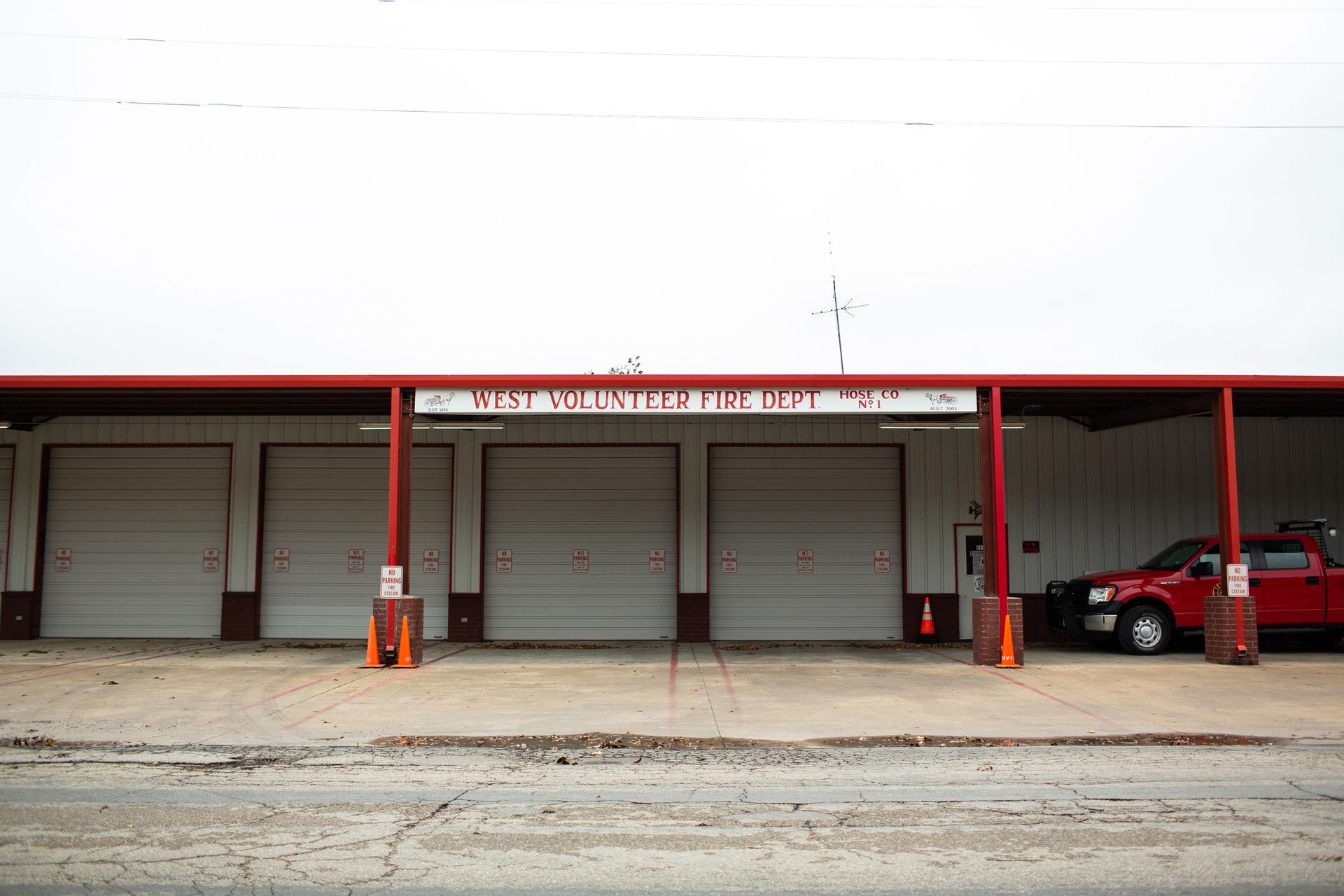
‘I had no idea it could do what it did’
Ammonium nitrate’s explosive capabilities were not well understood by the volunteer firefighters, who instinctively moved toward the fire on April 17, 2013, rather than away from it. They had toured West Fertilizer before and were mindful of the two tanks of anhydrous ammonia. But the ammonium nitrate was an afterthought.
“I knew it was volatile,” said Tommy Muska, the mayor, “but I had no idea it could do what it did.” One of the firefighters who died that night, Cody Dragoo, worked at the plant. “If he knew what that stuff could do when it catches fire and melts and becomes unstable, he would have got everybody out of there, as far away as we could get,” Muska said.
That’s what happened when the El Dorado Chemical facility in Bryan caught fire in 2009 and East Texas Ag Supply in Athens burned in 2014. In the latter case, the fire chief, seeing “the enormous scope of the fire and possibility of detonation of [ammonium nitrate] in the engulfed building,” told his firefighters to pull back, ordered evacuations within a five-block perimeter and let the place burn to the ground, the Chemical Safety Board reported. No one was injured.
The West firefighters were doomed, through no fault of their own, by their lack of knowledge. On a 103-degree day last summer, three of them — Muska, Robby Payne and pharmacist Kirk Wines — sat in a conference room at the rebuilt West Rest Haven nursing home and talked about the trauma their town had endured. The original nursing home, 600 feet from West Fertilizer, was gutted by the blast. Seventy-two of the 130 residents were injured by flying glass and other debris.
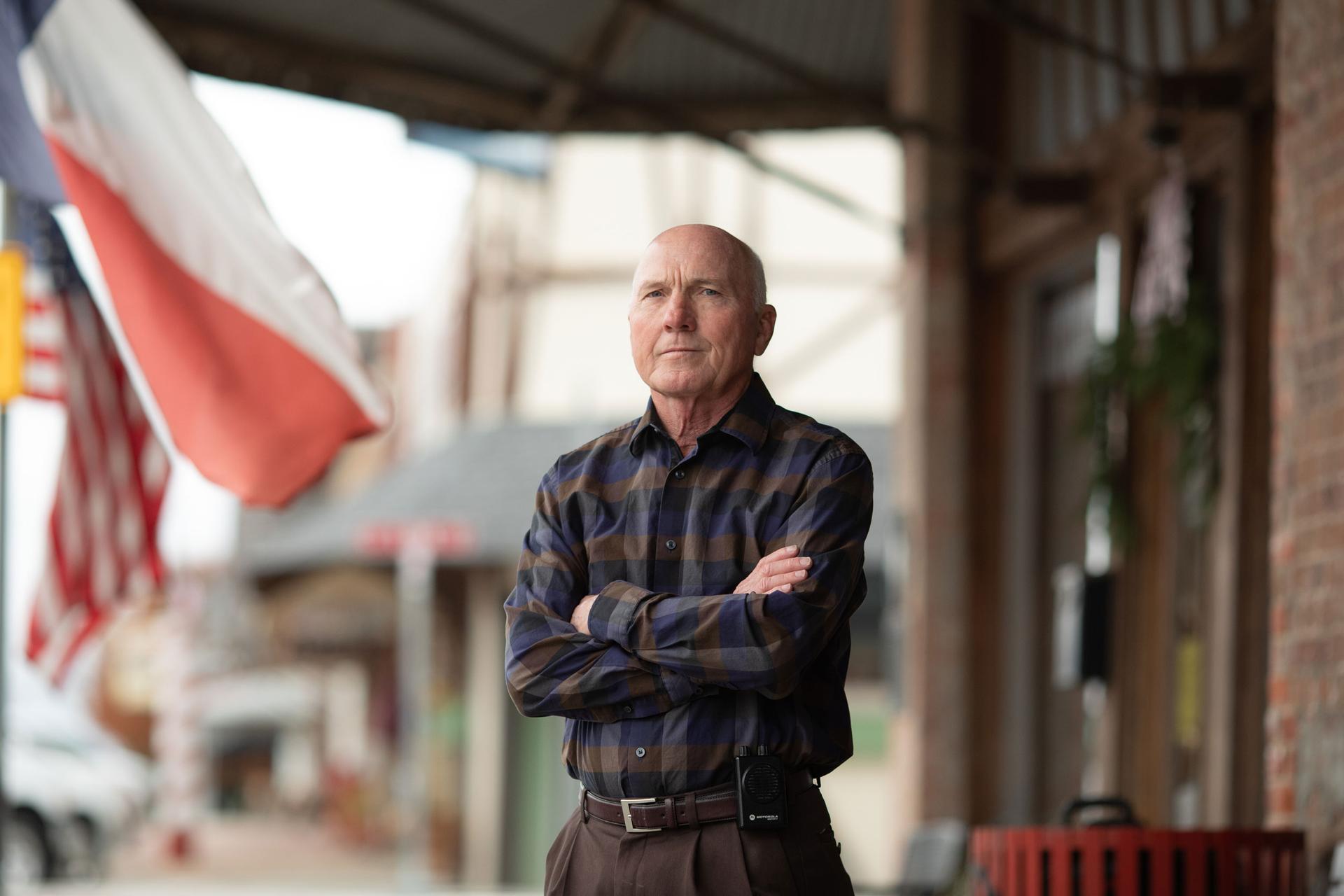
One resident died of a heart attack that night; the safety board counted his death among the 15 it blamed on the explosion. Within two months, another 14 residents died — an unusually high number, the board reported. Payne, president of the nursing home’s board of directors, believes this is not a coincidence.
Payne, a top-flight high jumper at Baylor University in his day, owns Aderhold Funeral Home in West and said he feels fine physically. His memory blackout spared him from the post-traumatic stress disorder that afflicted others in town.
Wines doesn’t have that luxury. He remembers that April night in excruciating detail: how, after donning his gear, he ran toward the fire, only to drop his gloves. How, as he turned back to pick them up, the place ignited and sent debris flying. How he felt no concussion and somehow remained upright. “I just recall standing there, watching. It seemed like everything was in slow motion.”
After Wines grasped what had happened, he saw one firefighter stumbling toward him, covered in white dust, another with blood dribbling from his ears. A third lay lifeless on a stretcher. Wines couldn’t go to church for almost a year afterward without crying. He gets emotional still when he describes how people went out of their way to help after the blast — sending money to his pharmacy, for example, to pay for others’ prescriptions.
Wines bristles when the subject of arson is raised. The ATF, he believes, “had to come up with something” after spending three years and $2 million on its investigation.
“I don’t blame anybody” for what happened at West Fertilizer, Wines said. “I think it’s a terrible accident. I think the firemen did their jobs.”
Muska, meanwhile, has presided over the town’s rebirth. Nearly all the demolished houses have been rebuilt, he said. The high school, junior high and intermediate school have been combined on a single campus. The city has spent $12 million on infrastructure repair and replacement — streets, water and sewer lines, a park. A memorial to the blast victims was dedicated last year.
“The people here in this area are always going to remember,” Muska said.
His worry is that the rest of the country won’t.
Public Integrity reporter Rachel Leven contributed to this story.
This story is a collaboration between The World and the Center for Public Integrity — a nonprofit, nonpartisan newsroom that investigates betrayals of public trust — as well as Grist, a nonprofit media organization covering climate, justice, and sustainability for a national audience.
You can sign up for the Center for Public Integrity’s newsletter here and Grist’s newsletter here.
Our coverage reaches millions each week, but only a small fraction of listeners contribute to sustain our program. We still need 224 more people to donate $100 or $10/monthly to unlock our $67,000 match. Will you help us get there today?
